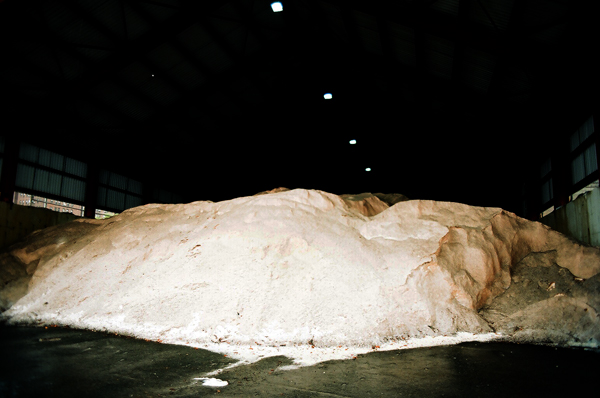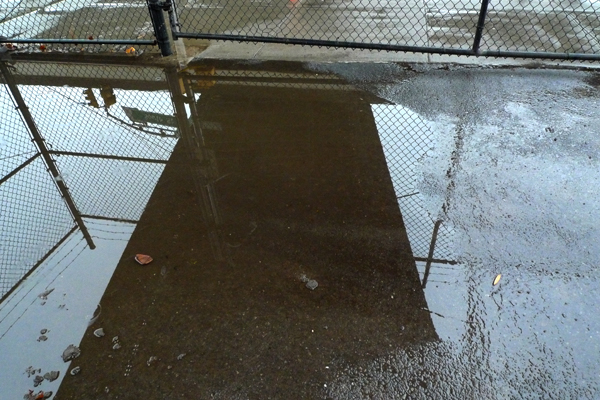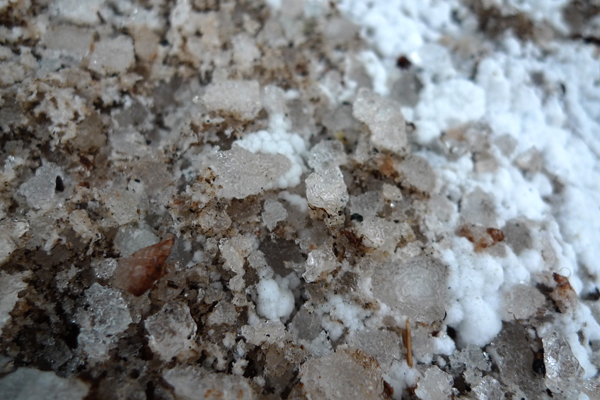Filed under: Uncategorized
 a massive Miocene deposit, currently located under the Manhattan Bridge
a massive Miocene deposit, currently located under the Manhattan Bridge
It was raining and we were standing outside a locked gate under the Manhattan Bridge. We were on a street we had never walked on before. Bridge traffic rumbled overhead and sent gushes of water cascading down onto the street around us. We had come to meet New York City’s Department of Sanitation Executive Officer for Public Information and Community Affairs. The arrangements for the day had been planned weeks ahead and our guide was already out of his car and unlocking the gate. Beyond the fence and inside the open-air warehouse, an enormous pinkish mound of what we had come to see rose almost to the ceiling.
To the Department of Sanitation, the materiality that brought us here is known as rock salt. It had arrived here from the Tarapacá Salt Flat in Chile via New York’s supplier, International Salt, a subsidiary of SPL (Sociedad Punta de Lobos) and a member of the K+S Group.
Once inside the fence, we faced a pile of geologic time that had become an ephemeral urban sculpture–an installation of deep time temporarily on view to select employees of the DSNY. What we saw won’t be there much longer. Despite being 8-10 million years old, in just a few months, these tons of solidified geologic time will slowly disappear as they are spread atop hundreds of miles of wintery New York City streets. The salt will mix with fresh snow and quietly dissolve in melt water on its way to sewer drains.
During a break in the rain, we came out from the shelter of our crumpled umbrellas and set up our cameras.
This site is just one of 44 salt storage locations scattered around the City. Last winter FOP wrote an in depth report about road salt in New York. The quick facts, according to the Commissioner of Sanitation, are these: Up to 235,000 tons of salt are stored each year at New York’s 44 storage sites. There are 365 salt spreaders and 2,000 sanitation trucks deployed to salt and clear more than 6,000 street curb miles when snow starts to accumulate.
Salt from various epochs of geologic time (and various geologic processes) gets put to many uses by humans: it’s the “road” surface for speed racing in Utah; it’s the storage medium for nuclear waste in southern New Mexico and Germany; we eat it; and, in the case of the towering mound of salt before us, it has been transported from the driest desert in the world to be spread on NYC’s snow covered streets.
FOP is particularly interested in how old this salt is and how it gets put to use by humans today. Part of our intention for the Geologic City project is to bring a sense of mystery and other-worldliness to familiar elements of the City’s geo-architecture and infrastructure. For example, you could see New York City road salt as a geologic material-become-Anthropocene-flow. It formed over millions of years only to be mined, traded, transported, applied and dissolved across thousands of miles of road in a matter of months. You could also see this salt as a space and time traveler from Earth’s planetary history that most humans can’t begin to fathom, or at least haven’t yet tried to imagine. The presence of this Miocene visitor to the City offers us an opportunity to make contact with a much earlier time. Before washing it down the City’s sewers as we clear paths for our contemporary means of transport–might we stop for a moment and consider that this material has existed on the planet 40 times longer than Homo Sapiens?
In our rush to de-ice streets with its crystals, might we have overlooked the possibility that this salt possesses some sort of mineral–if not bio–intelligence? It’s a real possibility, according to recent studies of Permian salt domes of southern New Mexico (currently being used to store our human- designed transuranic radioactive waste):
“Scientists have discovered water-filled air bubbles trapped in salt crystals that are fully a quarter billion years old… biophysicist Jack Griffith describes ancient cellulose fibers and even DNA that he’s found within such bubbles using an electron microscope. The material, he claims, is the oldest biological material ever discovered.” – Trapped in the Salt
There’s no telling what intelligence this pile of salt might share with anyone who will take notice before we wash it way.
| additional Geologic City posts can be read here: intro, 1 , 2 , 3 , 4 , 5 , 6 , 7 , 8 |
4 Comments so far
Leave a comment









these salt deposits are amazing looking! fantastic.
Comment by patty 10.15.2010 @ 8:22 am[…] Monument to the Miocene (Geologic City Report #6) […]
Pingback by Urban Infrastructure as Geologic Material in Motion (Geologic City Report #8) « Friends of the Pleistocene 11.30.2010 @ 9:28 am[…] Terrace 4. Stepping into Time: Rock Stairs 5. A Portal into the Present: Newtown Creek Nature Walk 6. Monument to the Miocene: Rock Salt Warehouse 7. From the Top of the Heap: Freshkills Park 8. Urban Infrastructure as Geologic Material in Motion […]
Pingback by Urban Omnibus » Geologic City 04.06.2011 @ 3:47 pm[…] sometimes overlooks what is right before our eyes. Until last autumn, when we visited one of many storage facilities in New York City for road salt, we hadn’t considered where all this 8 million year old salt goes after it melts the […]
Pingback by Tapping into the Flow: NYC’s Assemblage with Water (Geologic City Report #12) « FOP 08.12.2011 @ 2:14 pm